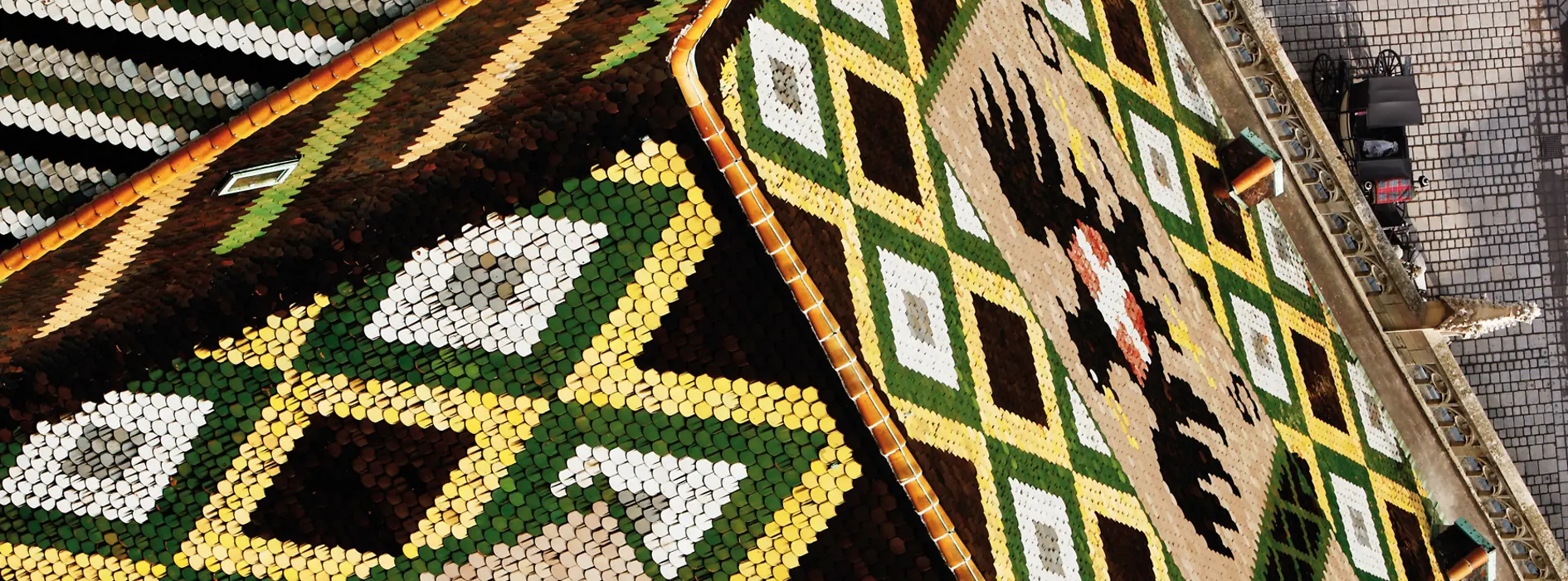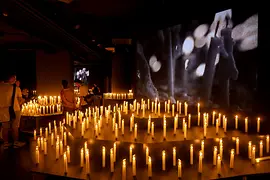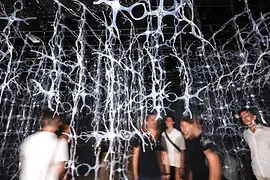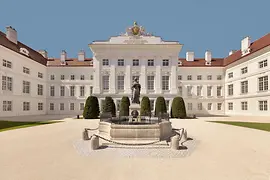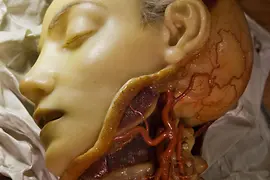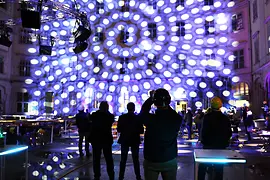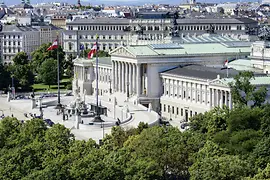Vienna Media News – September 2022 All Change at the Capital’s Cultural Institutions: New Arrivals and Reopenings in 2022/23
Mythos Mozart: Multimedia Experience at the Place of Mozart’s Death
The interactive, virtual Mythos Mozart experience opens on September 16, in the very spot that Mozart composed The Magic Flute and his Requiem – and where he died in 1791 (now Kärntner Strasse 19, basement level of the Steffl department store). Mozart lived in Vienna for ten years – a period which was also his most prolific.
The multimedia encounter with the musical genius is set up as a 60-minute round tour, which gets under way with Mozart’s Requiem – in a space where 1,500 candles, silhouette projection and sounds create an almost religious experience. A painted, animated 360-degree panorama showing what the city looked like in the composer’s day dominates the second room: Mozart’s Vienna. Mozart’s World of Music has a much more hands-on focus, while Mozart’s Genius turns the spotlight on his creativity. The tour concludes with a series of fantastic digital images in the Mozart Forever room.
Back to the 18th century thanks to technology: the magic world was made possible by an international team of experts and artists. Contributions range from works by the Anglo-German lighting designer Moritz Waldemeyer to poetic animations that transport visitors to the historical Vienna of 1791. Other highlights include an installation by the Los Angeles-based new-media artist Refik Anadol, who uses artificial intelligence to distill Mozart-centric images and data into digital visual worlds. The experience uses 50 special projectors, a dozen large-format screens, around 200 loudspeakers and an innovative sound system. The combination of music, performing arts, architecture and technology – all elaborately stage managed – gives Mythos Mozart its unique appeal.
And the soundtrack was made in Vienna. The music for the project was recorded and engineered by students from the mdw – University of Music and Performing Arts Vienna (second place in the 2022 QS World University Rankings). Mythos Mozart’s ambassadors are star tenor Rolando Villazón, Belgian soprano and model Elise Caluwaerts, and virtuoso violinist Aleksey Igudesman. Mythos Mozart is the fruit of a collaboration involving the Salzburg Mozarteum Foundation, the Berlin State Library, the Society of Friends of Music in Vienna, the Mozarthaus Vienna and the Wien Museum.
- 1st district, Kärntner Strasse 19, www.mythos-mozart.com
Josephinum: A Fresh Look at Medical History
The Josephinum in the ninth district, which contains the collections of the Medical University of Vienna, will reopen on September 29 following a renovation project lasting almost four years. The fully refurbished and extended museum in the ninth district now has around 1,000 square meters of exhibition space.
Heritage-listed, the classicist original building which dates back to the 18th century was completely gutted and returned to its original state wherever possible. A special highlight is the historic, nine-meter-high semicircular lecture theater. The 1940s suspended ceiling was removed to reveal the original ceiling paintings from 1785, and the square outside and the main entrance were redesigned.
Home to one of the world’s leading historic medical collections, the Josephinum has an illustrious history: it was on this spot that Emperor Joseph II commissioned the construction of a training academy for military physicians and surgeons in 1785. The world-famous anatomical wax figures he purchased in Florence are a focal point of the present-day museum. It also features a wealth of other important artifacts that chart advances in medical history, including surgical instruments, images, books, archive material, handwritten notes and items left behind in various estates. Many of the exhibits will be put on display to the public for the first time in the new Josephinum.
- 9th district, Währinger Strasse 25, www.josephinum.ac.at
Schütte-Lihotzky Center: Museum for an Pioneering Architect
One of Vienna’s top female pioneers is set to be honored with her own museum in 2022: the architect Margarete Schütte-Lihotzky. From October, her last apartment, on Franzensgasse in Vienna’s fifth district, will be open to visitors twice a week (Tuesdays and Fridays). Schütte-Lihotzky lived in the now heritage-listed apartment – which she designed herself – until her death in 2000.
Over the past few months her 55m² apartment (plus 35m² terrace) has been carefully restored. Besides renovation work (including measures to reinstate the original colors of the walls), a significant proportion of the fixtures and fittings were replicated, including lamps, curtains, tables and fabric coverings. An almost 100-year-old Kyrgyz wall hanging was painstakingly restored by a team of experts, and the terrace refurbished and replanted. A tour of the apartment is designed to deliver an authentic insight into Schütte-Lihotzky’s life and work. The museum is set up as an exhibition and education space as well as a center for research into various pioneering female architects. The project is backed by the Margarete Schütte-Lihotzky Club, an independent association which was established in 2013.
Margarete Schütte-Lihotzky shaped the time she lived in forever. A social housing pioneer, she was also an advocate of women’s liberation, a peace activist and resistance fighter against National Socialism. Her best-known creation came in 1926 with the invention of the fitted kitchen, which she dubbed the Frankfurt Kitchen. But Schütte-Lihotzky, a protégée of the Austrian Architect Adolf Loos, vehemently refused to be pigeonholed by her greatest invention. Schütte-Lihotzky was one of the first women to study architecture in Vienna and the first to practice her vocation on a significant scale.
- 5th district, Franzensgasse 16/40, www.schuette-lihotzky.at
Info and press photos: www.schuette-lihotzky.at
Parliament: Fresh Perspectives and Insights
Vienna has a reputation as a major political center – municipal, federal and world political decision making takes place here. One of the city's key political hubs is the Parliament, the seat of the Austrian National Council and Federal Council. In January 2023, a root and branch renovation program – which started in 2018 – will be completed. And the magnificent building on Ringstrasse will celebrate its reopening.
Going forward, the Parliament will be a more open place for everyone: a new visitor center (admission is free) will offer an insight into the inner workings of government, while a glass fronted gallery will open up views directly into the Plenary Hall below. And, high above the venerable old parliament building, a new walkway leads up to the freely accessible terrace which, besides a restaurant, offers fantastic views of the city.
The Parliament was built between 1874 and 1883 according to plans drawn up by the star architect Theophil Hansen. Designed in the Greek revival style, the building was inspired by a Hellenic temple. After 140 years, all signs of wear and tear have been addressed and the building has now been brought up to the technological state of the art. During the mammoth project, some 55,000 square meters of floor space, 740 windows and around 600 historic doors were renovated. The main chamber, the roof and the famous Pallas Athena fountain in front of the parliament are also back to their very best. A special focus was placed on sustainability during the renovation project: processes were enhanced, use made of wasted space and energy efficiency brought up to standard. Numerous measures were also taken in terms of accessibility.
- 1st district, Dr.-Karl-Renner-Ring 3, www.parlament.gv.at, https://sanierung.parlament.at
Alte Post: A Sensory Odyssey
A new public space dedicated to culture is currently taking shape in the Stubenviertel in the first district. Known as the Alte Post, this sprawling complex of buildings which served as the HQ of Austrian Post between 1850 and 2011 is gearing up for its next lease on life as a mixed-use facility. Once construction is complete it will comprise apartments, offices, cafés and restaurants, a hotel, leisure facilities and various cultural institutions. Its new occupants are gradually moving in – a coworking space set the ball rolling in September 2022. Once completed in mid-2023, it will serve as a versatile, cosmopolitan hotspot in the middle of the city center for residents and visitors alike.
Responsibility for the area’s artistic design falls to the SHA.ART creative team – a group of experts centering on the Viennese artist and perception researcher SHA. Conceived as a 360-degree art experience, a multi-dimensional media artwork is currently taking form, which is designed to have an effect on each of the human senses. Anyone interacting with it will enter a parallel world and look into the future as well as into the past. Futuristic animations will be integrated, as well as archaeological excavations found on site in cooperation with the Wien Museum.
Between now and completion, quarterly preview festivals spanning several days will continued to be held. Open to the public, these events are intended to offer deeper prototypical insights. The first of these was the Vienna Garden, which took place at the beginning of September in the neighboring Dominikanerhof courtyard and was organized jointly with Ars Electronica Linz. The next mini-festival is scheduled for December, with the Gesamtkunstwerk – or total work of art – itself due to open in mid-2023.
- 1st district, Dominikanerbastei 11, www.sha-art.com
Contact
Helena Steinhart
Media Relations
+43 1 211 14-364
helena.steinhart@vienna.info
